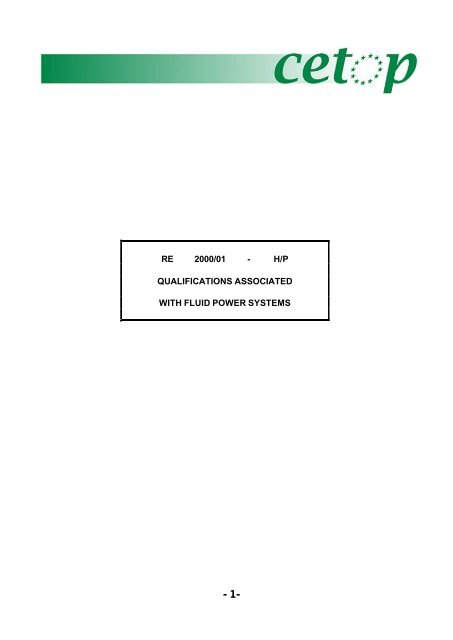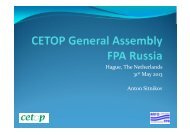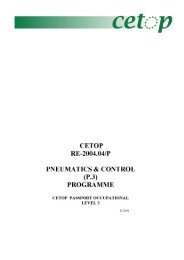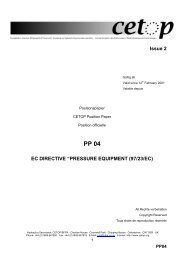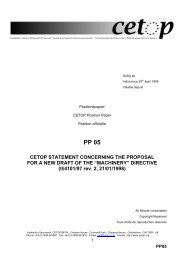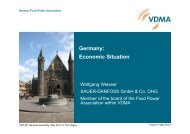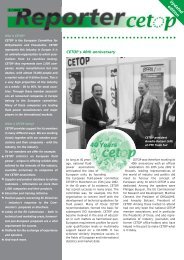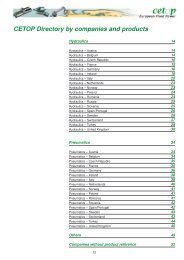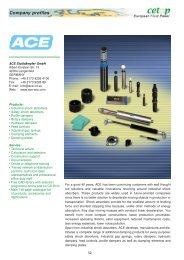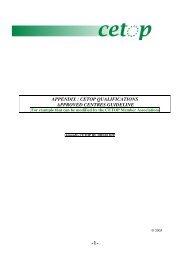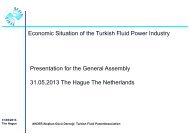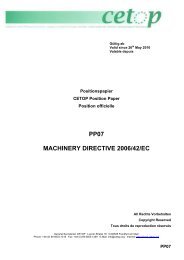CETOP RE 2000-01 - CETOP European Fluid Power
CETOP RE 2000-01 - CETOP European Fluid Power
CETOP RE 2000-01 - CETOP European Fluid Power
- No tags were found...
You also want an ePaper? Increase the reach of your titles
YUMPU automatically turns print PDFs into web optimized ePapers that Google loves.
<strong>RE</strong> <strong>2000</strong>/<strong>01</strong> - H/PQUALIFICATIONS ASSOCIATEDWITH FLUID POWER SYSTEMS-1-
1. INTRODUCTION1.1 What is <strong>CETOP</strong>?1.2 Education Proposal1.3 The Aim1.4 What are COMPETENCE BASED QUALIFICATIONS?1.5 Occupation Levels Vs Knowledge Based/Competence Programmes of Study2. COMPETENCE IN FLUID POWER SYSTEMS2.1 <strong>CETOP</strong> Occupational Levels2.2 Knowledge Based and Competence Based Skills by level2.3 Technical Terms-2-
1. INTRODUCTION1.1 What is <strong>CETOP</strong>?Founded in 1962, <strong>CETOP</strong> is the <strong>European</strong> Oil and Hydraulics Committee andrepresents the National <strong>Fluid</strong> <strong>Power</strong> Associations within the fourteen <strong>European</strong>countries, in-turn representing some 1000 companies throughout Europe.<strong>CETOP</strong> supports, promotes and provides aid to the fluid power industry and preparesstandards and guidelines in co-operation with the technical committees of ISO(International Organisation for Standardisation), CEH (<strong>European</strong> Committee ofStandardisation) and the various National Standards Organisations.More detailed information may be obtained by visiting the <strong>CETOP</strong> Website atwww.cetop.org.1.2 Education and Training Proposal and Harmonisation initiative for EuropeWith the ever-growing need throughout Europe and the world for a COMPETENT,WELL EDUCATED WORKFORCE, able to maintain and manage fluid power systems;<strong>CETOP</strong> have taken the initiative to put forward a proposal to develop an harmonisationprogramme relating to the qualifications of such a workforce.1.3 The Aim is to develop an acceptable and agreed structure of “Competence BasedQualifications” reflecting the needs of those people who fall into the categories coveredby OCCUPATIONAL LEVELS 1, 2 and 3 (see appendix 1). Such a structure will reflectthe needs of those people in employment or being prepared for a particular level ofemployment.1.4 What are COMPETENCE BASED QUALIFICATIONS?Historically, many people have achieved a qualification that represents a “level ofacademic attainment” and does not always relate to that person’s ability to apply theirknowledge to a “real life situation”.The real life skills associated with Maintenance and Management of fluid powersystems are work related and are as follows:• PLANNING AND P<strong>RE</strong>PARING• INSTALLING• COMMISSIONING• TESTING• MAINTAINING• FAULT DIAGNOSIS AND <strong>RE</strong>CTIFICATION• <strong>RE</strong>MOVAL AND <strong>RE</strong>PLACEMENT• DISMANTLING AND <strong>RE</strong>ASSEMBLING-3-
To carry out these tasks at the various “occupational levels” and achieve a level ofperformance and repeatability within a given time will require that person to beCOMPETENT.A “Competence Based Qualification” will therefore consist of a combination of bothknowledge and application of the knowledge, supported by practical experience in theworkplace or under simulated conditions.1.5 OCCUPATIONAL LEVELS -Vs KNOWLEDGE BASED/COMPETENCE BASED PROGRAMMES OF STUDY TOMEET THE OCCUPATIONAL NEEDSThe following provides an example to enable the reader to clearly see the difference inknowledge based levels under consideration.A relief valve is used as the example and this ANOLOGY outlines the difference inknowledge requirements at the various levels and clearly indicates where training andexperience plays its part.<strong>RE</strong>LIEF VALVEAt Level 1-At Level 2 -At Level 3 -At Level 4 -At Level 5 -the candidate needs to know what a relief valve is, what it does and why.(Basic Function.)the candidate needs to know in addition to the above, how the reliefworks. (Function and Operation.)the candidate also needs to know the different applications that a reliefvalve can be used for (unloading, proportional control) and what can gowrong. (Function, Operation, Application and Technical Specification.)the candidate would need all level 3 and could be involved in the aspectsof design, component selection and compatibility.the candidate needs all the above levels plus the skills and knowledgenecessary to design or re-design the relief valve itself.Using this example it can be seen that although a level 5 person needs toknow the same as a level 1 person, there is a distinct difference in breadthand depth. Level 1 is a broad approach with very little depth, whilst level 5is a much deeper approach covering a broader range of subjects.• From base level to Level 1 requires only education and training, work-basedactivities will be repetitive, following established procedures and requires very little-4-
experience and knowledge of other areas.• From Level 1 to Level 2 requires education and training with an acquired level ofcompetency allied to experience to meet Level 2 Occupational requirements.• From Level 2 to Level 3, a greater depth and breadth of knowledge is requiredcompared to level 2, with a knowledge of other subject areas complementary to fluidpower. At level 3, the competence-based skills should clearly reflect a level ofexperience able to deal with the broader and more complex range of activitiesrequired to fulfil this occupational level.• Level 4 and 5 will require experience and knowledge from other areas ofengineering and will require a greater degree of core skills and knowledge.Covering such items as: materials, stress calculations, mathematics, physics,production techniques, technical specifications and available technology.-5-
2. COMPETENCE IN FLUID POWER SYSTEMS2.1 OCCUPATIONAL LEVELSLEVEL (1) This person will perform activities that follow an establishedprocedure. Activities will be recurring and of a short termnature. The reaction to most problems will be to summon helpor follow a predefined set of actions.LEVEL (2) This person will perform a variety of activities and needsunderstanding of the technical factors involved.The activities may require the interpretation and application ofvaried and non routine specifications. Activities will involvethe use of simple diagnostic checks and ability to make apositive response to deviations. Co-operation with others inteam or work groups may be required.LEVEL (3) This person will be involved in a broad and often complex rangeof activities, often requiring independent decisions to be madeon technical matters concerning specifications, resources orprocesses. Planning of work will be a responsibility as will thefinding and rectification of faults. Responsibility for the qualityof work undertaken and the required outcomes are also included.LEVEL (4) & (5) will be defined later-6-
2.2 KNOWLEDGE BASED & COMPETENCE BASED SKILLSCOMPONENTSKBCB KB CB KB CBL1 L2 L3• types• construction• function• operation• application• performance/ characteristics• selection/recommendations• sizing• mounting/ interface• control systems/interface• installation• commissioning/setting up• malfunction and effects• testing• fault diagnosis• removal and replacement• dismantle• re-assemble• contamination tolerance/awareness• technical data• use of formulae/calculations• system design/compatibility• safety precautions/features• risk assessment/use• physical attributes (noise etc.)• legislation/directives/standardsWSDWSDWSDWSDWSDKNOWLEDGE BASED = KBCOMPETENCE BASED = CBWITHIN THE SCOPE OF THEIR DUTIES = WSDNOTE- although the may appear in a number of levels, the breadth and depth of the subjectsdiffer from level to level-7-
SYSTEMS•planning- projects/actions•technical data/specifications•circuit diagrams•control systems/options•control system interfaces•configuration•operation•application•installation (parts and whole)•commissioning•modifications•recommendations for improvement•health monitoring (con: monitoring)•performance monitoring (ditto)(procedures and use of diagnostics)•interpretation of results•routine maintenance•proactive/ predictive maintenance•contamination management/control•fault diagnosis•fault rectification•fault-cause analysis•corrective actions•safe working procedures•re-commissioning procedures•hydraulic and compressed airfluid(management/selection)•risk assessment•legislation/ directives/standardsKB CB KB CB KB CBL1 L2 L3WSDWSDWSDKNOWLEDGE BASED = KBCOMPETENCE BASED = CBWITHIN THE SCOPE OF THEIR DUTIES =WSD-8-
CO<strong>RE</strong> SKILLS / KnowledgeKB CB KB CB KB CBL1 L2 L3•fundamental PRINCIPLES•use of formulae and calculations•technical report writing•communications•information technology•presentation skills•planning skills•preparing procedures/work instructions•reading and interpretation technical data/circuit diagrams•translation of information•analysis of facts•organisational management•quality management•safety management•power and motion control interfacesWSDWSDWSDWSDWSDWSDWSDKNOWLEDGE BASED = KBCOMPETENCE BASED = CB-9-
2.3 TECHNICAL TERMS USEDRelating to COMPONENTSTypeConstructionFunctionOperationApplicationPerformance/characteristicDifferent components used within a system.e.g. gear pumps, vane pumps, piston pumps screw compressor, vanecompressor. Lubricators, dryers, coolers e.t.c.Individual design attributes.e.g. a pump may have a splined shaft, a relief valve may be sub-platemounted, compressors fully packaged .cushioned cylindersPurpose or specific activity.e.g. the function of a relief valve is to limit the pressure to a particular level,3port-2position valve to operate single acting cylinder.Specific performance.e.g. a relief valve poppet lifts off its seat when the system pressurecreates a force upwards, greater than that of the downward force of theopposing spring.Relates to the function of a component within a circuit or system.e.g. a pressure reducing valve may be used to specifically limit thepushing force on a small press cylinder.Refers to the dynamic operation of a component.e.g. pressure override of a pressure control valve, slippage rate of apump, pressure drop across a proportional directional control valve. FADfor a compressor, pressure drop in pipes.Selection/ Types and choice available and why a particular componentrecommendations would be selected in preference to another.SizingMounting/interfaceControl system/interfaceInstallationRelating to range and capacity.e.g. flow and pressure range to meet a specific requirement.Refers to ISO /NG/<strong>CETOP</strong> SAE, pipe mounted,flange mounted, screw in e.t.c.Pilot operation, solenoid operation, ‘bang-bang’ orproportional, digital or analogue .solenoid/ pilot, detent.Procedures to be followed when fitting a component into a systemor part of a system, new or replacement.-10-
Commissioning/setting-upProcedures to follow to meet a required performancespecification. e.g. setting up of a compensator on a pump to 150 bar.Speed of a cylinder and cushioningMalfunction andeffectsTestingFault diagnosisRemoval/replacementDismantleRe-assembleContaminationtolerance/awarenessTechnical dataUse of formulae/calculationsSystem design/compatibilitySafetyprecautions/featuresRefers to deviation in performance, possible causes and theeffect on the system.Checking the settings of a component meet a specific performance(involving diagnostic equipment).Following procedures to identify a fault against specific symptoms,evaluation of the facts to identify a cause and implementation of a solutionto rectify and prevent a re-occurrence.Procedures to be followed, including safe working practicesand the correct use of tools and equipment. Compliance with allspecifications and manufacturer recommendations.Procedures to be followed, including the correct use of tools andequipment, following safe working practices and compliance withmanufactures recommendations and specifications.Procedures to be followed, including the correct use of tools andequipment, following safe working practices and compliance withmanufactures recommendations and specifications.Refers to manufacturers cleanliness recommendations forcomponents to effectively perform, plus knowledge of targetcleanliness levels and methods of achieving and maintaining them.Refers to manufacturers catalogue information and recommendationsspecific to a particular component.Refers to fundamental formulae to determine informationspecific to component size, performance, flow rate, pressure drop e.t.c.Refers to a components performance characteristics, size,construction e.t.c. to meet a system specification in conjunction with othercomponents.Refers to specific component safety features and/or thesafety precautions to be taken when a particular component becomespart of a system.-11-
Risk assessment/ Refers to the investigation of a component within a system touseidentify any possible safety hazards during use and the necessaryrecommendations/precautions to be implemented.PhysicalattributesLegislation/directives/standardsRefers to noise, heat generation, vibration (belonging to or caused by).<strong>European</strong> Standards, ISO Standards, Health & Safetyrequirements and directives, Machinery Directive. Specificlinks to component application in a particular system.TECHNICAL TERMS USEDRelating to SYSTEMS.Planning - Preparing a documented plan of actions relating to a specificprojects/actions task involving: -• Procurement.• Compliance.• Staffing/resourcing.• Time-based action plan.• Review/evaluation.• Installation/commissioning.• Hand-over/declaration of conformance.Technical data/specificationCircuit diagramsUse of manufacturers catalogues and data sheets withreference to recommendations for ‘setting up’, installation and testing.Symbolic representation of components and systems to meet the requiredISO specification.Control systems/ Open and closed loop (continuous and discontinuous), digitaloptions and/or analogue options, pump control system options.Control systemInterfacesConfigurationOperationApplicationInstallationDigital and analogue systems (use of PLC’s and bussystems, pilot control).Open systems, closed hydrostatic transmission system. List of specificcircuits relating to a particular application).Specific performance at system level (involving a number of components).Specific system function (operational specification).Procedures to be followed when configuring a system from individual-12-
components (involving planning and preparation).CommissioningPreparing a system for ‘active duty’, setting up of the component parts tomeet a performance specification.ModificationProcedures to be followed when alterations are made to a system forexample, the need to update technical documentation and theperformance specification to ensure that any modifications are incompliance with the manufacturers specification and all requirements tohealth and safety.Recommendations Reports relating to system improvements specific to afor improvement particular aspect of its performance, maintenance safety and operationalmanagement.Health (condition) Procedures set up to determine system and componentmonitoring performance that meets the operation of the specification with referenceto: -• <strong>Fluid</strong> condition to meet target cleanliness levels.• Noise and vibration.• Temperature.• General leakage.• Documentation & report.PerformancemonitoringProcedures set up to determine that system and componentperformance meets the required operation specification with reference to:-• Pumps – Q/P testing.• Actuator speeds.• Operational pressures.• Documentation & report.Interpretation ofresultsRoutinemaintenancePro-active/predictivemaintenanceReferring to health and performance monitoring, translatingresults into an action plan with clear ‘outcome objectives’ as part of thepro-active maintenance programme.Maintenance activities that are time based – daily, weekly,monthly etc and follow a ‘set checklist’ approach.Maintenance activities carried out as part of a plan forcontinued improvement and/or relating to specific conditionmonitoring.-13-
Contaminationmanagement/controlRefers to that of maintaining cleanliness levels that meet theTARGET CLEANLINESS LEVEL and ensuring thatprocedures are in place to achieve and maintain this at all times.Where a non-compliance is identified, procedures should be in place toenable remedial action to be taken and cause to be evaluated.sFault diagnosis Procedures to be followed, to effectively diagnose a fault within a system.Fault rectification Procedures to be followed, to effectively rectify a fault with a system and tore-establish the system to a fully operational status.Fault – Cause -AnalysisManagement procedures in place to investigate the cause ofa fault and the necessary steps to implement preventative measuresagainst a re-occurrence.Corrective actions A report outlining actions to be taken to overcome and prevent the reoccurrenceof a fault or that of fault prevention identified as part of theprogramme for continued improvement.Re- commissioning Plan of action inline with manufacturers recommendationsProcedures and operational/technical specifications for the system to become fullyoperational.<strong>Fluid</strong> Management/Selection andTreatment Refers to control procedures relating to :- Oil procurement , storage ,transportation ,filling and dispensing systemswhilst in use in the machine to final disposal with regard to all aspects ofhealth and safety.- Compressed air , contaminants and purity classes with regard to allaspects .Risk assessment Refers to the investigation of a system by a competent person to identifyany possible hazards during use and the necessaryrecommendations/precautions to be implemented to prevent danger to allpersons involved with that system.Legislation/directives/<strong>European</strong> Standards, ISO Standards, Health & Safetyrequirements and directives, Machinery Directive. Specific-14-
standardsinks to systems and their application.-15-


